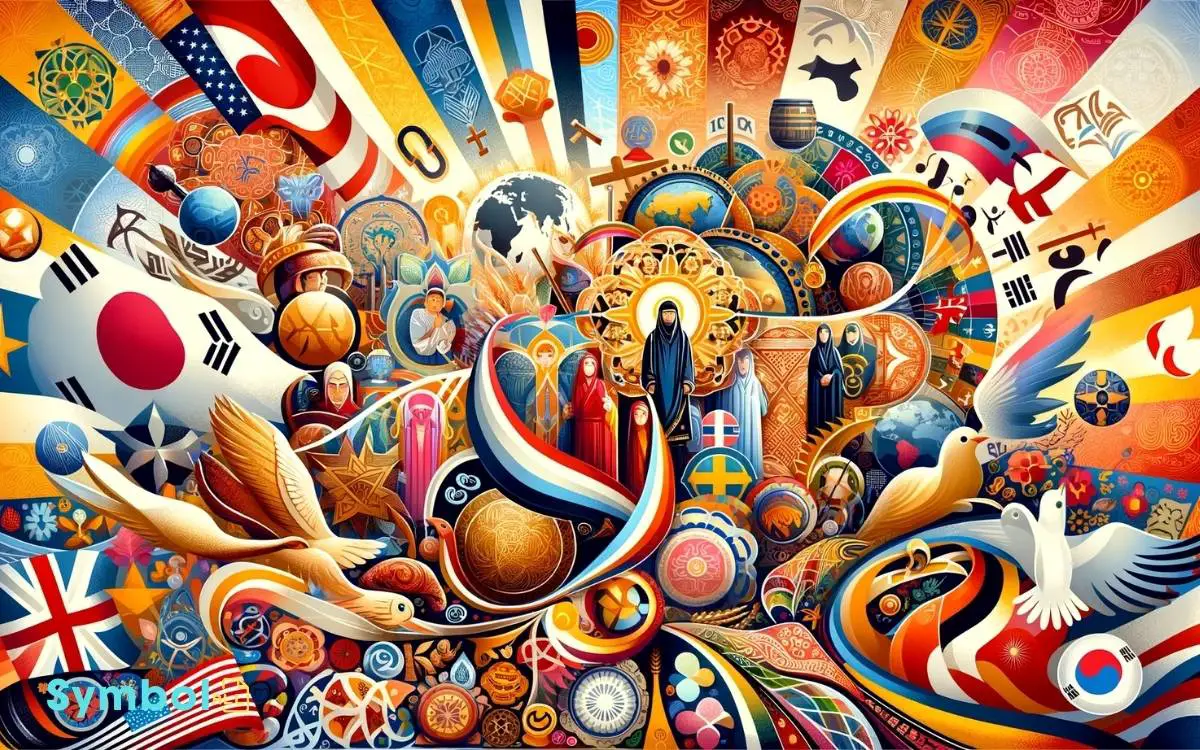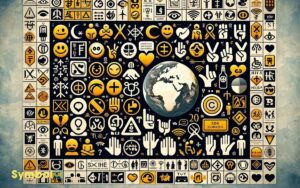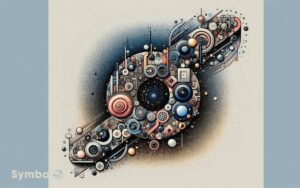How Is the Use of Symbols Related to Culture? Communicate!
Symbols are the essence of your culture, encapsulating values and beliefs unique to your society. Across cultures, symbols can vary greatly, reflecting each community’s unique ethos.
They aren’t static; as ideologies evolve, so do symbols, reshaping to mirror current beliefs. In art, symbols anchor cultural identity, fostering pride within communities.
Politically, symbols can undergo drastic rebranding, influencing and reflecting societal shifts. Religious symbols, deeply spiritual, act as moral compasses, while national symbols forge collective identities.
Through symbols, you engage with deep-seated cultural nuances and navigate the complexities of identity. Uncovering their layers offers a richer understanding of the world’s cultural tapestry.

Key Takeaways
Defining Cultural Symbols
Cultural symbols, serving as the DNA of societal values, encapsulate and communicate the profound intricacies of a community’s identity and beliefs. You’ll find these markers vary widely across cultures, acting as a mirror reflecting the unique ethos of each society.
For example, the eagle represents freedom and strength in American culture, while the lotus holds profound spiritual significance in Hinduism and Buddhism, symbolizing purity and enlightenment.
This comparative lens reveals not just the diversity of symbols but also their shared roles in embodying ideals, morals, and communal bonds.
Analyzing these symbols, you’re engaging with the fabric that weaves together the narrative of a people’s history, aspirations, and worldview, offering a window into the collective psyche that transcends linguistic barriers, inviting a deeper understanding of humanity’s cultural tapestry.
Historical Evolution of Symbols
Building on our understanding of cultural symbols as the DNA of societal values, it’s important to explore how these symbols have evolved over time to reflect changing cultural landscapes and ideologies.
You’ll find that symbols aren’t static; they’re dynamic, shifting with societal transformations. For instance, consider how the swastika, originally a symbol of good fortune in various cultures, underwent a drastic rebranding in the 20th century due to its adoption by the Nazi Party.
This evolution underscores the fluid nature of symbols, influenced by historical events, political movements, and social changes.
Symbols in Religious Practices
Throughout history, religious practices have richly employed symbols to convey deep spiritual meanings and connect believers with their faith.
You’ll find that these symbols, while diverse, share common roles across various religions, acting as bridges to the divine, moral compasses, and embodiments of complex theological concepts.
| Religion | Symbol | Meaning |
|---|---|---|
| Christianity | Cross | Sacrifice and salvation |
| Islam | Crescent Moon and Star | Sovereignty of God |
| Buddhism | Lotus | Purity and enlightenment |
| Hinduism | Om | The universe’s spiritual essence |
| Judaism | Star of David | Divine protection and identity |
This comparative view highlights how symbols serve not just as identifiers of religious affiliations but as profound conveyors of spiritual wisdom and communal identity.
Through these symbols, you can glimpse the interplay between the tangible and the sacred, grounding abstract beliefs into something palpable and universally recognizable.
National Symbols and Identity
Just as religious symbols shape spiritual identities, national symbols play a pivotal role in forging and expressing collective national identity.
You’ll find that each country has its unique set of emblems, such as flags, anthems, and monuments, which serve as a point of pride and unity among its citizens.
These symbols aren’t merely decorative; they encapsulate historical narratives, values, and aspirations that resonate deeply with the population.
For instance, consider how the cherry blossom represents delicate beauty and the transient nature of life in Japanese culture, whereas the bald eagle in the United States symbolizes strength and freedom.
Despite their varied forms, these symbols universally act as anchors, grounding people in a shared heritage and guiding them towards a common future. Through these emblems, national identity isn’t only communicated but also continually redefined and reinforced.
Language as Symbolic Expression
You observe that languages evolve, adopting symbols that mirror societal changes, reflecting how communities perceive themselves and the world around them.
Metaphors, in particular, serve as a lens through which cultural identities are both shaped and understood, highlighting the intricate relationship between language and cultural expression.
This comparative analysis underscores the role of linguistic evolution and metaphorical language in crafting and expressing cultural identity, offering insights into the dynamic nature of symbolic communication.
Symbolism in Linguistic Evolution
Reflecting societal values and beliefs, language evolves as a dynamic form of symbolic expression, constantly reshapped by cultural interactions and historical contexts. You’ll observe this as you compare languages across regions and epochs.
Words and phrases act as symbols, not just of objects or actions, but of complex ideas and traditions unique to each culture. For instance, idioms that make little sense when directly translated from one language to another reveal deep-seated cultural nuances.
As societies interact, merge, or confront each other, their languages absorb symbols from one another, leading to linguistic evolution.
This process mirrors the ever-changing tapestry of human experience, highlighting how language isn’t just a tool for communication but a living archive of humanity’s collective journey.
Metaphors Shaping Cultural Identity
Building on the understanding that language acts as a dynamic symbol of cultural expression, metaphors emerge as powerful tools in shaping cultural identity.
You’ll find that every culture crafts its metaphors, which reflect and reinforce its values, beliefs, and shared experiences. These linguistic symbols serve not just as decorative language but as windows into how a community interprets the world.
For instance, while English speakers might ‘see the light’ to signify understanding, another culture might use a metaphor involving a different sense or element, illustrating a unique worldview.
This comparative lens reveals how metaphors aren’t mere linguistic ornaments but foundational elements that construct and communicate cultural identity.
They’re the threads weaving the fabric of cultural narratives, influencing how you perceive, interact with, and even reshape your world.
Art and Symbolic Interpretation
You observe that in various cultures, art serves as a canvas for embedding symbolic meanings, ranging from societal values to historical narratives.
By comparing cultural icons represented in artistry across societies, you uncover layers of symbolic interpretation unique to each community.
This approach not only enriches your understanding of art but also offers a window into the diverse ways cultures communicate their essence and beliefs through visual mediums.
Symbolic Meanings in Art
How do artists embed layers of meaning within their work, using symbols that resonate across cultures and eras?
The process is intricate, reflecting deep-seated cultural values and human experiences. Artists often draw from a shared pool of symbols, yet the interpretation can shift dramatically between contexts.
| Symbol | Cultural Context | Possible Interpretation |
|---|---|---|
| Water | Various | Life, purity, renewal |
| Owl | Western vs. Eastern | Wisdom vs. ill omen |
| Cross | Christian | Faith, sacrifice |
| Lotus | Eastern | Enlightenment, purity |
| Raven | Indigenous cultures | Transformation, creation |
This comparative approach allows you to see how a single symbol can carry multiple layers of meaning, highlighting the diversity of human thought and expression across cultures. This underscores the profound role that the use of symbols in communication plays in shaping our understanding of the world. By examining these symbols through a comparative lens, we gain insights not only into different cultural identities but also into shared human experiences. Ultimately, this exploration reveals how symbols bridge gaps in understanding while also celebrating the uniqueness of diverse perspectives.
Cultural Icons in Artistry
Exploring further, let’s examine the role of cultural icons in artistry, where artists imbue their works with symbols that not only reflect but also shape societal values and identities.
This intricate relationship between art and culture fosters a deeper understanding in several ways:
- Reflection of Collective Memory: Art serves as a canvas for the collective memory, capturing and preserving cultural milestones.
- Evolution of Societal Norms: Through symbolic representation, artists challenge and redefine societal norms, fostering dialogue and growth.
- Cultural Identity and Pride: Symbols in artistry anchor cultural identity, fostering a sense of pride and continuity among community members.
Rituals and Symbolic Acts
Why do societies across the globe engage in rituals and symbolic acts that, while diverse, often share underlying similarities?
At the heart, rituals serve as a means to express and reinforce the values and beliefs of a culture.
You’ll find that these practices, whether they’re rites of passage, religious ceremonies, or seasonal festivals, provide a tangible way to navigate the intangible aspects of life and communal identity.
Through comparative ethnography, it’s evident that symbols used in these rituals like water, fire, or specific gestures—carry deep meanings, transcending language barriers and fostering a sense of unity and continuity.
Clothing and Symbolism
Clothing serves as a vibrant tapestry of symbols, woven with the threads of cultural identity and personal expression, revealing much about society’s values, status, and beliefs.
Through the lens of ethnography, one observes how apparel acts as a non-verbal communication tool, reflecting deeper meanings about the wearer and their cultural background.
- Traditional garments often encapsulate history, signifying one’s roots and communal ties.
- Color choices in attire can symbolize various emotions or societal roles, differing vastly across cultures.
- Fashion trends mirror current societal norms and shifts, indicating collective movements towards change or preservation.
This comparative analysis highlights clothing as not just a necessity but a rich, symbolic language, varying significantly across cultures yet universally serving as a marker of identity and societal values.
Symbols in Architecture
As you delve into the domain of architecture, you’ll find that styles and meanings are deeply intertwined, reflecting both historical contexts and cultural identities.
Iconic structures worldwide stand as affirmations to this reality, each telling its own unique story through design and form.
The influence of culture on architectural design bridges continents and epochs, revealing the shared human penchant for embedding symbolism in our built environments.
Architectural Styles and Meanings
Throughout history, architectural styles have served as profound symbols, reflecting the cultural, social, and religious values of their societies.
When you explore the architectural landscape, you’ll find that:
- Gothic cathedrals in Europe, with their soaring spires and intricate stained glass, symbolize a connection to the divine and the light of God penetrating the darkness.
- Traditional Japanese homes, with their sliding doors and tatami mats, emphasize harmony with nature and the importance of simplicity and functionality.
- Brutalist buildings, characterized by their raw concrete construction, represent a post-war era’s honesty, functionality, and a rejection of frivolity.
Each style tells you more about the people and the era it originates from, offering insights into their priorities, beliefs, and social structures.
Iconic Structures Worldwide
Around the globe, iconic structures stand as powerful symbols, embodying the cultural, spiritual, and historical ethos of their respective societies. You’ll find that each edifice, from its inception, narrates a story of its people, beliefs, and aspirations.
The construction materials, design principles, and even the chosen locations contribute to a narrative that transcends language, offering a window into the soul of a culture.
| Structure | Location | Symbolic Meaning |
|---|---|---|
| Eiffel Tower | Paris, France | Innovation, Romance |
| Great Wall of China | China | Strength, Unity |
| Taj Mahal | Agra, India | Eternal Love, Purity |
This table showcases how diverse elements converge in architecture to communicate universally recognized values and emotions, fostering a deeper connection amongst global citizens.
Cultural Influences on Design
Cultural norms and values deeply influence architectural design, shaping structures into symbols that reflect the identity and heritage of a society.
You’ll find that across cultures, buildings are more than mere shelters or spaces for activities; they’re embodiments of cultural narratives and beliefs.
Analyzing these designs offers you insights into the society’s priorities, values, and connection to their environment or history.
- Geometric patterns in Islamic architecture symbolize the infinite nature of Allah, illustrating a deep spiritual significance.
- Tall spires in Gothic cathedrals aim to reach the heavens, reflecting Christian aspirations towards the divine.
- Circular designs in Indigenous architecture often represent the concept of life and continuity, emphasizing a harmonious relationship with the earth.
These elements showcase how deeply interwoven architectural practices are with cultural identities, revealing a rich tapestry of human expression and belief systems.
Food as Cultural Symbols
Many societies use food not just as sustenance, but as a profound symbol that embodies their cultural identity and heritage. For instance, consider the intricate Japanese tea ceremony, which isn’t merely about drinking tea but signifies a deep respect for tradition and social harmony.
Similarly, the American Thanksgiving turkey represents gratitude and familial bonds. Across the globe, these culinary practices offer a window into how communities value and interpret their world.
Through the lens of food, you’ll notice that each dish tells a story, reflecting historical events, social structures, and spiritual beliefs.
It’s a rich tapestry where flavors, ingredients, and preparation methods aren’t random but are deeply entwined with the cultural fabric, illustrating how people connect with their roots and express their identity.
The Global Exchange of Symbols
In the age of globalization, symbols of culture, from art to cuisine, traverse borders, blending and reshaping identities in their wake. You witness the fusion of traditions and the birth of new cultural expressions, as symbols acquire multiple meanings across different contexts.
This global exchange impacts cultures in various ways:
- Promotion of cross-cultural understanding: Sharing symbols fosters a deeper appreciation of diverse cultures.
- Risk of cultural homogenization: Unique symbols may lose their distinctiveness.
- Creation of hybrid identities: Individuals blend symbols from multiple cultures, forming new, complex identities.
This dynamic interplay not only enriches global culture but also challenges you to reconsider the meaning and significance of symbols within your own cultural context.
Conclusion
As you wander through the tapestry of human culture, you’ll find symbols woven into every corner, from the towering spires of temples to the intricate patterns on traditional garments.
These symbols serve as the heartbeat of societies, pulsing with the stories and values of countless generations.
Whether it’s the universal language of food or the silent pride in a national flag, symbols bridge our worlds, knitting together the fabric of humanity in a vibrant mosaic of shared understanding and distinct identities.






